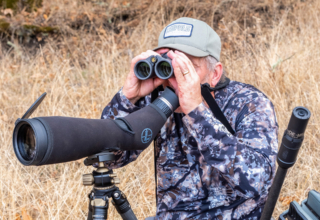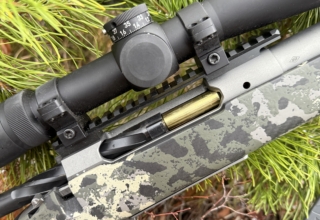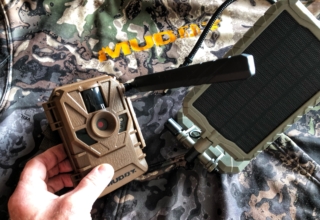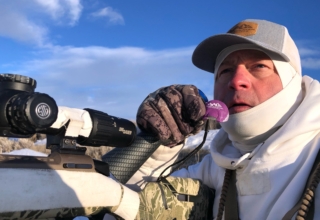Schnee’s Pac Boot Hunter II is an indestrctible boot, and this 30-plus-year field test proves why.
by Mark Kayser
Winter in my region of the country, northern Wyoming, tests the best of you and your winter gear. Every time I plunk down in a snowbank to call coyotes, I’m reminded of that. An hour-long sit may not seem like an eternity. However, if the coyotes play hard to get and temperatures plunge below freezing, maybe even below zero, an hour seems like forever. Not being prepared could lead to frostbite or even death. This is especially true if the situation turns south badly, i.e., getting your truck stuck.
I am always searching for the latest technology to ward off the chills. A good example is Muddy Outdoors’ line of Nucleus clothing. Gloves, socks, tops, bottoms, and even a heated muff all provide the crackling heat of a mobile campfire. Each item is easily recharged with USB-compatible cords to ready the 3.7-volt, 3,500mAh Nucleus Power Bank. These items fall into the “New School” category of gear. Press a button and feel the heat oozing into your gloves, socks, vest, and undies.
What I’m about to propose as something you should investigate has “Old School” written all over it and comes with more than a 30-year field test. Here’s AN ACTUAL field test that dates back to before many of you were born.

Around Christmas in the late 1980s or very early 1990s (quit doing the math; I’m old) is when this story starts. My new wife and I had exchanged gift ideas months prior. Back then, I was living in the Great Plains with aspirations to keep moving West. On my list was a mountain boot, the Schnee Hunter II 13-Inch Pac Boot. Through research (old school, no internet), observations, and talking with fellow hunters, I found that they would be great for nearly any winter environment, especially the mountains, if and when I made that move.
Sure enough, on Christmas morning, I unwrapped the shiny new boots my bride had purchased for me straight from Bozeman, Montana. They fit perfectly. As I marveled at the great gift, I admired the detailed stitching in the leather and the heavy-duty stitching that mated the 13-inch leather upper to the Pac Boot bottom.

Today, Schnee refers to the tread as the Advantage Tread, with a cleated outer ring supported by a peg-style inner tread design. Overall, it grips excellent in snow, slick grass, and the rocky terrain of the icy mountains. I also appreciated the shapely toe design crafted to fit into most oversized horse stirrups. My wife had horses well before our marriage and was slowing transitioning me into a cowboy. I ride my saddle horse and mule even today.
Rounding out the boot is the 400-gram insulated boot liner. Even at a glance, it would easily outperform the box-store pac boot liner I used then. I nearly lost my toes from numerous battles with frostbite using that sub-par liner. My worst example was plunging through a beaver-weakened ice patch and soaking my left leg up to the knee. I had to hike back to my truck, nearly a mile away, in negative-degree temps. My foot, boot, and clothing froze solid, and it was a horrible experience. I was more than happy with my new Christmas gift.
My early field tests started in eastern South Dakota, the southern part of the North Dakota tundra landscape many joke of. Subzero temperatures with windchills dipping below minus 50 were common. A few years later, I moved slightly west to live in the Missouri River breaks and sprawling western South Dakota expanses. Jaunts would take me into the Black Hills and even Montana, where I worked as a licensed guide. Throughout, my Schnee boots propelled me across frozen yucca plains, snow-covered gumbo breaks, and the true mountain West.

Finally, I made the official move to “Forever West” Wyoming, and the Schnee boots continue to impress. They kept my toes warm during horseback hunts in the mountains, coyote hunts in the foothills, and deer hunts across the country’s middle part when I had to travel. I wore them on many early-season shed antler hunts as well. When I had to break ice and wade across rivers, they did not leak. They never gave way to full days in slushy snow, either. The tall height acts as a built-in gaiter.

I opted for a slightly larger boot size, which was half-size and bigger during fitting. Why? The slightly larger size allows air to circulate through your toes. Warm air is insulation. You can also wear a slightly heavier sock. Finally, the extra space in extreme conditions is perfect for a stick-on-toe warmer to fit nicely into the boot and boost warmth. Cold toes are no fun.
After more than three decades of use, you can imagine the wear these boots have seen. No problem! The Schnee boot company rebuilds your boots. I have used this service and highly recommend it. Pick out the Pac Boot bottom of your liking, and they will remove the old, worn pac bottom and replace it with a new one. Liners can also be purchased and replaced. It is an economical option that trumps buying new boots every few years and breaking them in. I also need to share one last secret. Oil your boots! Whether using my Schnee Pac Boot or Kenetrek Mountain Extreme boot, I religiously oil them to keep the leather supple and the stitching from drying out. You cannot believe how many more years you get from a boot with regular mink oil or a boot conditioning concoction.
A boot like this does not see service every month of the year, which is another reason for its longevity. Basically, I put these boots into my duffel starting in November and put them back on the shelf by late March. Some outings call for the Pac Boot, while for others, I can get away with a regular mountain boot such as the Kenetrek.
I lost count of the number of deer and elk I tagged wearing these boots or the number of shed antlers I picked up, but late this fall, I was invited on a late-season horseback hunt in central Montana. Along with my standard elk hunting gear, I packed my scabbard, chinks, and my trusty (ancient) Schnee boots. The hunt would take place using horses, and once again, my Schnee Pac Boot did not disappoint me. Riding miles into the backcountry and stalking elk along rocky slopes were no match for my footwear, even in freezing temps. A fast stalk on a huge elk herd at sunset resulted in a late-season meat addition to our freezer.

The Schnee Pac Boot has been in production for approximately 40 years, so I got in on the initial vogue movement of this boot. The model I use costs $379, but think about that spread over a lifetime. It’s affordable winter protection and a boot you can pass on to your grandkids.











